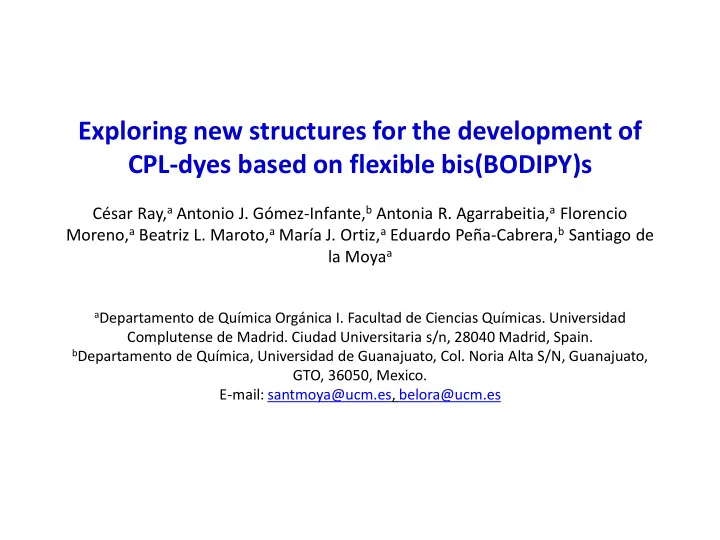

Exploring new structures for the development of CPL-dyes based on flexible bis(BODIPY)s César Ray, a Antonio J. Gómez-Infante, b Antonia R. Agarrabeitia, a Florencio Moreno, a Beatriz L. Maroto, a María J. Ortiz, a Eduardo Peña-Cabrera, b Santiago de la Moya a a Departamento de Química Orgánica I. Facultad de Ciencias Químicas. Universidad Complutense de Madrid. Ciudad Universitaria s/n, 28040 Madrid, Spain. b Departamento de Química, Universidad de Guanajuato, Col. Noria Alta S/N, Guanajuato, GTO, 36050, Mexico. E-mail: santmoya@ucm.es, belora@ucm.es
Exploring new structures for the development of CPL-dyes based on flexible bis(BODIPY)s Introduction and background Circularly Polarized Luminiscence : CPL Differential emission of left and right-hand polarized light Importance High resolution provided by the circular polarization of the light Development of smarter materials for useful technologies: Information storage Imaging 3D display and processing (ellipsometry- Spintronics-based based devices tomography) Specific interaction with chiral mater → control of the morphology in nanomaterials detection of chiral environments (chiral sensing) Asymmetric photochemistry
Exploring new structures for the development of CPL-dyes based on flexible bis(BODIPY)s Introduction and background I I I L R g 1 1 lum – 2< g lum <+2 CPL I I I L R 2 2 Highest values of g lum : lanthanide complexes (low fluorescence quantum yield) Simple organic molecules (CPL-SOMs): Small size physiological CPL applications - Excellent solvent solubility CPL-active dye-doped inclusion materials - CPL-SOMs are rare Low g lum values: 10 -5 – 10 -3 - - Small number of chiral designs (highly inefficient synthesis) - High CPL activity Low-cost - High emission efficiency effective New structural designs are necessary, with: - Synthetic accessibility materials
Exploring new structures for the development of CPL-dyes based on flexible bis(BODIPY)s Introduction and background Helically labile bis(haloBODIPYs): an advantageous platform for the development of CPL-SOMs A new structural design for CPL-SOMs. All-in-one: - synthetic accessibility - capacity for reversing the polarization handedness - helical lability - reactive functional groups making possible photophysics modulation Ray, C.; Sánchez-Carnerero, E. M.; Moreno, F.; Maroto, B. L.; Agarrabeitia, A. R.; Ortiz, M. J.; López-Arbeloa, Í.; Bañuelos, J.; Cohovi, K. D.; Lunkley, J. L.; Muller, G.; de la Moya Cerero, S. Chem.-Eur. J. 2016, 22 , 8805-8808
Exploring new structures for the development of CPL-dyes based on flexible bis(BODIPY)s Synthetic strategies for the modification of the parent structure Objectives Structure-activity relationships studies Towards the optimization of theCPL properties Strategy 1 Modify the dihedral angle (Sterical hindrance and rigidity in the flexible bridge) Strategy 2 Explore new positions for the connection of the chromophores
Exploring new structures for the development of CPL-dyes based on flexible bis(BODIPY)s Results Strategy 1 Modify the diedral angle Based on: de la Moya Cerero, S. and col. Chem.-Eur. J. 2016, 22 , 8805. Sterical hindrance Rigidity
Exploring new structures for the development of CPL-dyes based on flexible bis(BODIPY)s Results Strategy 1 Synthesis Bis(BODIPY) BODIPY R Nu base solvent temperature (% yield) (% yield) p -tolyl 9a Et 2 PrN dioxane reflux 1A (traces)* 1B (71) p -tolyl 9b Et 2 PrN CH 3 CN reflux 2A (38) 2B (32) p -tolyl 9c Et 2 PrN CH 3 CN reflux 3A (54) 3B (36) 4A § (52) 4B § (-) p -tolyl 9d K 2 CO 3 CH 3 CN reflux § Ray, C.; Banuelos, J.; Arbeloa, T.; 5A § (87) 5B § (-) mesityl 9d K 2 CO 3 CH 3 CN reflux Maroto, B. L.; Moreno, F.; Agarrabeitia, A. R.; Ortiz, M. J.; Lopez-Arbeloa, I.; de 6A § (82) 6B § (-) CF 3 9d K 2 CO 3 CH 3 CN reflux la Moya, S., Dalton Transactions 2016, 7A § (82) 7B § (-) p -tolyl 9e K 2 CO 3 CH 3 CN reflux 45 , 11839 * 1A was obtained from 1B with excess of 3,5-dichloroBODIPY under the same conditions (65% yield)
Exploring new structures for the development of CPL-dyes based on flexible bis(BODIPY)s Results Strategy 2 Explore new positions for the connection of the chromophores Based on: de la Moya Cerero, S. and col. Chem.-Eur. J. 2016, 22 , 8805.
Exploring new structures for the development of CPL-dyes based on flexible bis(BODIPY)s Results Strategy 2 Synthesis 15 / 9f Yield of Yield of ratio 10A (%) 10B (%) 17 46 2:1 borsm: 26 borsm: 72 1:1 - 98
Exploring new structures for the development of CPL-dyes based on flexible bis(BODIPY)s Results Strategy 2 Synthesis
Exploring new structures for the development of CPL-dyes based on flexible bis(BODIPY)s New series of chiral conformationally labile helical bis(BODIPY)s for Conclusions studying structure - CPL activity relationships Strategy 1 Dihedral angle Strategy 2 New positions Optimized CPL properties??
Recommend
More recommend